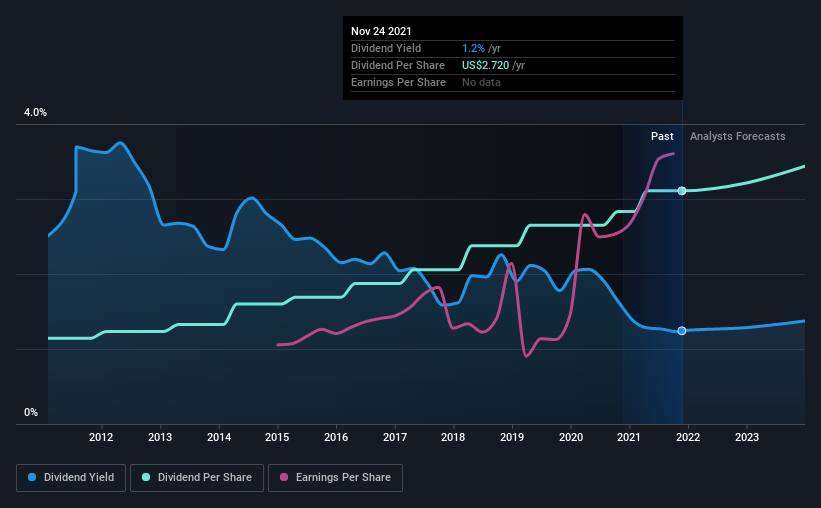Be Sure To Check Out Avery Dennison Corporation (NYSE:AVY) Before It Goes Ex-Dividend
Readers hoping to buy Avery Dennison Corporation (NYSE:AVY) for its dividend will need to make their move shortly, as the stock is about to trade ex-dividend. Typically, the ex-dividend date is one business day before the record date which is the date on which a company determines the shareholders eligible to receive a dividend. The ex-dividend date is of consequence because whenever a stock is bought or sold, the trade takes at least two business day to settle. This means that investors who purchase Avery Dennison's shares on or after the 30th of November will not receive the dividend, which will be paid on the 15th of December.
The company's next dividend payment will be US$0.68 per share. Last year, in total, the company distributed US$2.72 to shareholders. Last year's total dividend payments show that Avery Dennison has a trailing yield of 1.2% on the current share price of $218.85. If you buy this business for its dividend, you should have an idea of whether Avery Dennison's dividend is reliable and sustainable. So we need to check whether the dividend payments are covered, and if earnings are growing.
Check out our latest analysis for Avery Dennison
Dividends are typically paid from company earnings. If a company pays more in dividends than it earned in profit, then the dividend could be unsustainable. Fortunately Avery Dennison's payout ratio is modest, at just 29% of profit. A useful secondary check can be to evaluate whether Avery Dennison generated enough free cash flow to afford its dividend. It distributed 26% of its free cash flow as dividends, a comfortable payout level for most companies.
It's encouraging to see that the dividend is covered by both profit and cash flow. This generally suggests the dividend is sustainable, as long as earnings don't drop precipitously.
Click here to see the company's payout ratio, plus analyst estimates of its future dividends.
Have Earnings And Dividends Been Growing?
Stocks in companies that generate sustainable earnings growth often make the best dividend prospects, as it is easier to lift the dividend when earnings are rising. If business enters a downturn and the dividend is cut, the company could see its value fall precipitously. That's why it's comforting to see Avery Dennison's earnings have been skyrocketing, up 25% per annum for the past five years. Earnings per share have been growing very quickly, and the company is paying out a relatively low percentage of its profit and cash flow. Companies with growing earnings and low payout ratios are often the best long-term dividend stocks, as the company can both grow its earnings and increase the percentage of earnings that it pays out, essentially multiplying the dividend.
The main way most investors will assess a company's dividend prospects is by checking the historical rate of dividend growth. Avery Dennison has delivered an average of 11% per year annual increase in its dividend, based on the past 10 years of dividend payments. It's exciting to see that both earnings and dividends per share have grown rapidly over the past few years.
Final Takeaway
Is Avery Dennison an attractive dividend stock, or better left on the shelf? We love that Avery Dennison is growing earnings per share while simultaneously paying out a low percentage of both its earnings and cash flow. These characteristics suggest the company is reinvesting in growing its business, while the conservative payout ratio also implies a reduced risk of the dividend being cut in the future. There's a lot to like about Avery Dennison, and we would prioritise taking a closer look at it.
While it's tempting to invest in Avery Dennison for the dividends alone, you should always be mindful of the risks involved. Case in point: We've spotted 2 warning signs for Avery Dennison you should be aware of.
We wouldn't recommend just buying the first dividend stock you see, though. Here's a list of interesting dividend stocks with a greater than 2% yield and an upcoming dividend.
This article by Simply Wall St is general in nature. We provide commentary based on historical data and analyst forecasts only using an unbiased methodology and our articles are not intended to be financial advice. It does not constitute a recommendation to buy or sell any stock, and does not take account of your objectives, or your financial situation. We aim to bring you long-term focused analysis driven by fundamental data. Note that our analysis may not factor in the latest price-sensitive company announcements or qualitative material. Simply Wall St has no position in any stocks mentioned.
Have feedback on this article? Concerned about the content? Get in touch with us directly. Alternatively, email editorial-team (at) simplywallst.com.

